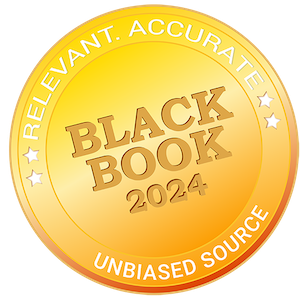
“Is this claim valid? How much is our financial responsibility?” These are the two big questions payers want to answer when adjudicating healthcare claims. Huge amounts of patient information, clinical data, diagnostic and billing codes, and policy specifications must be analyzed and cross-checked to verify that the right amount is paid to the right party. It’s a complex process. Even the smallest error can result in a claim being rejected or denied, dragging out payment timelines and eating up provider profits. That’s why healthcare providers should reevaluate their claims adjudication process.

Experian Health is pleased to announce that we’ve ranked #1 in Claims Management and Clearinghouse, for our ClaimSource® claims management system, according to the 2024 Best in KLAS: Software and Professional Services report.
The claim adjudication process is a pivotal step in the revenue cycle and determines a provider’s reimbursement for services rendered. It’s a complex process with many moving parts, which means errors or delays can occur at many points along the way. A smooth, streamlined system can reduce the amount of time and money spent on claims adjudication for both the payer and the provider. Here are six steps to improving claim adjudication processes for a better bottom line.
What is claims adjudication?
Claims adjudication is the process by which insurance companies thoroughly review healthcare claims before reimbursement or payout. During this process, they decide whether to pay the claim in full, pay a partial amount, or deny it altogether.If more information is needed, the claim will be rejected and marked as “pending.”
Insurance companies employ this systematic procedure to determine the validity, accuracy, and eligibility of claims against the terms and conditions of their policy. During claims adjudication in healthcare, insurance payers assess the documentation provided by the service provider, examining factors such as the nature of the services, coverage details, and any applicable deductibles. The process can take weeks to resolve itself. This evaluative process ties up billions of dollars in an endless cycle of claims denials and resubmissions.
Following this evaluation, the provider will reject or settle the claim. Additionally, claims adjudication may lead to partial settlements or modifications based on the assessment of the claim. By all accounts claims denials are exceedingly common; a recent Experian Health survey showed that these numbers have increased by up to 15% annually.
Healthcare providers can implement several steps to mitigate the risk of denials, enhance the efficiency of claims adjudication and get paid faster.
Steps to improving the claims adjudication process
The healthcare reimbursement process is bogged down with manual tasks that create errors. Experian Health’s State of Claims 2022 report revealed that the most common claims errors include:
- Missing or incomplete prior authorizations
- Failure to verify provider eligibility
- Mistakes in medical coding
Yet providers have new technologies at their fingertips to improve how and when they get paid. McKinsey reports on data showing that applying the latest artificial intelligence (AI) and automation digital tools to the revenue cycle could save healthcare providers up to $360 billion annually. That makes these tools a kind of adjudication insurance to protect providers against costly claims denials. Here are six ways to apply technology to improve the claims adjudication process.
Step 1: Invest in automation
Some of the benefits of automating healthcare claims management include:
- Streamlined operations with fewer human errors.
- Less staff time tied up in claims adjudication.
- Better data with real-time insights into patient and payer trends.
- Faster claims processing—and faster payment.
- Better patient experiences.
- Happier staff.
Applying AI and automation to claims management can eliminate errors by allowing the technology to validate and cleanse data at the point of entry. Tools like Experian Health’s Claim Scrubber can thoroughly review each line of claim data in seconds. Alerts can flag a human attendant, allowing them to correct mistakes before claim submission.
Automation technology like the Enhanced Claim Status streamlines the revenue cycle by tracking the claims adjudication process in real-time. Instead of submitting a claim and awaiting the payer’s response, this technology provides claim statuses within 24 to 72 hours.
Step 2: Prevent delays with front-end edits and save time spent in claims adjudication
How much time could providers save by correcting front-end mistakes before the claims adjudication process begins?
During claims adjudication, payers will compare claims data to payer edits, to make sure billed services are coded correctly. Therefore, providers must keep pace with current coding requirements and the universal, local and payer-specific edits that apply.If claims are not correct the first time, they’ll fail the payer’s initial automated review, and may be denied or pushed into a queue for manual review by a claims examiner, leading to inevitable delays. Front-end claims editing tools can find errors that might prevent reimbursement, such as missing prior authorization or coordination of benefits codes.
Patient Access Curator, Experian Health’s latest revenue cycle data curator package, helps healthcare providers eliminate errors quickly on the front-end. This solution uses AI to perform eligibility, COB, Medicare Beneficiary Identifier (MBI), demographics and discovery in a single solution, preventing denials at the front end with a single click, within seconds.
Experian Health’s ClaimSource® solution allows organizations to implement customized edits and rules tailored to specific payer requirements. These edits help catch errors related to coding, billing, or other aspects of the claim, preventing inaccuracies from progressing to claims adjudication. While the industry average for claims denials is 10% and higher, Experian Health clients who use ClaimSource have a typical denials rate of just 4%. That’s one reason Experian Health’s ClaimSource solution earned the top KLAS ranking for the second consecutive year.
Step 3: Streamline record-keeping and data management
Electronic record keeping plays a pivotal role in ensuring accuracy in healthcare claims. These platforms allow centralized storage of patient data, including medical history, treatment plans, and billing information. Electronic record systems can enforce standardized coding practices, ensuring that medical codes used for billing and claims adhere to industry standards. They also maintain detailed audit trails, documenting all changes and updates made to patient records. This level of accountability enhances accuracy by allowing organizations to trace any modifications and ensure data integrity throughout the claims adjudication process.
Notably, electronic record-keeping systems seamlessly integrate with healthcare claims management systems. Integration ensures that the information entered into electronic health records (EHR) automatically populates relevant fields in the claim, minimizing the need for manual data entry and reducing the risk of transcription errors.
Step 4: Automatically review coding for accuracy
Coding errors can result in claim denials and delay reimbursements to providers. For example, manual coding introduces the risk of typos or misinterpretation of the medical record. Because of the complexities of payer requirements, an incorrect procedure or diagnosis code could trigger claim rejection. Some procedures require supporting documentation or pre-verification before treatment. At the same time, ICD-10 (codes for patient diagnosis) and CPT codes (that identify services rendered) undergo regular updates. Failing to stay on top of these coding systems increases the risk of a rejected claim.
The solution is to apply AI and automation to improve the chance of claims adjudication success. Two solutions from Experian Health include:
- AI Advantage™ – Predictive Denials uses AI to spot documentation errors before the claim goes to adjudication. The solution automatically flags claims with a higher potential for denial, allowing the revenue cycle team to fix errors before claim submissions. For claims that have already been denied, AI-Advantage Denial Triage identifies and prioritizes high-value denials, so teams can focus on remits with the highest impact.
- Denial Workflow Manager allows providers to quickly identify denied claims early in the claims adjudication process. Remittance details show providers the steps necessary to amend the claim quickly for a higher chance of reimbursement. Intelligent data-driven denial analytics spot the root causes of denials, so remedial action can be taken.
Step 5: Create clear patient communication channels
Clear patient communication channels are essential for preventing errors in healthcare claims adjudication. Incorrect patient information can result in claim denials, causing delays in reimbursement and impacting both patients and healthcare providers. Automated patient outreach technology significantly enhances communication while reducing the likelihood of errors. Solutions like Patient Access Curator also work to capture accurate patient data at registration – all in a single click.
Electronic patient portals, powered by automation software, can also solve this challenge. These portals empower patients to update their information directly, ensuring the accuracy of data submitted with claims. Patients can verify and input their demographic details, insurance information, and other relevant data through user-friendly interfaces. Electronic patient portals significantly reduce the risk of errors in patient information by minimizing manual data entry and streamlining the information-sharing process. These tools enhance the efficiency of the claims adjudication process, reduce the likelihood of denials, and promote a smoother experience for patients and healthcare providers.
Step 6: Advocate for policy change
Moving towards claims adjudication automation with uniform industry standards can save providers and payers time and money. Currently, each payer operates within their unique silo of ever-changing reimbursement requirements. A lack of standardization means providers spend hours checking claims against payer requirements.
The first step toward industry standardization requires automation technology to eliminate these time-consuming manual processes. Digital solutions like Experian Health’s online prior authorizationsoftware update requirements directly from payer websites, giving providers a better shot at submitting a clean claim.
Advocating for healthcare policy change toward greater automation and more uniform industry standards is a strategic move that will save time and money and foster a more efficient, transparent, and technologically advanced healthcare ecosystem. This transformation will improve patient care and overall system sustainability.

Experian Health was client-rated #1 by Black Book™ ’24 in Denial & Claims Management Outsourcing, Health Systems.
Improving healthcare claims management with Experian Health
Today, nearly 20% of all healthcare claims are denied, and 60% are never resubmitted. That ties up significant revenue in the claims adjudication process. However, better claims management processes can yield reduced denials and faster payments.
Experian Health offers a complete ecosystem of tools to deliver cleaner claims and faster reimbursement. This suite of products creates an integrated technology ecosystem with a track record of increasing the speed at which healthcare providers get paid.
Find out more about how Experian Health’s Claims Management solutions can support a more streamlined claims adjudication process.


